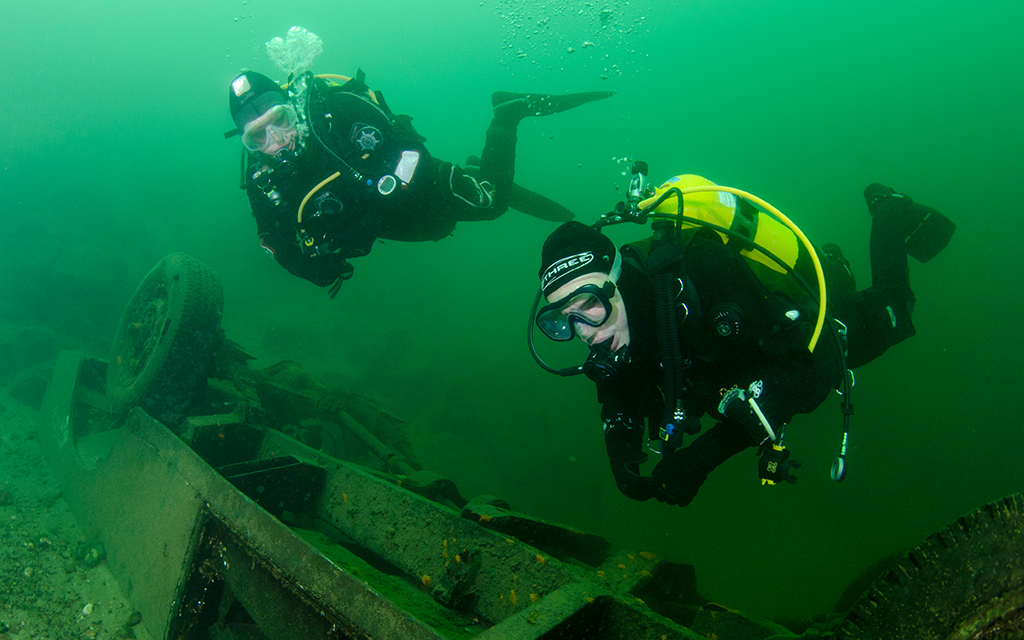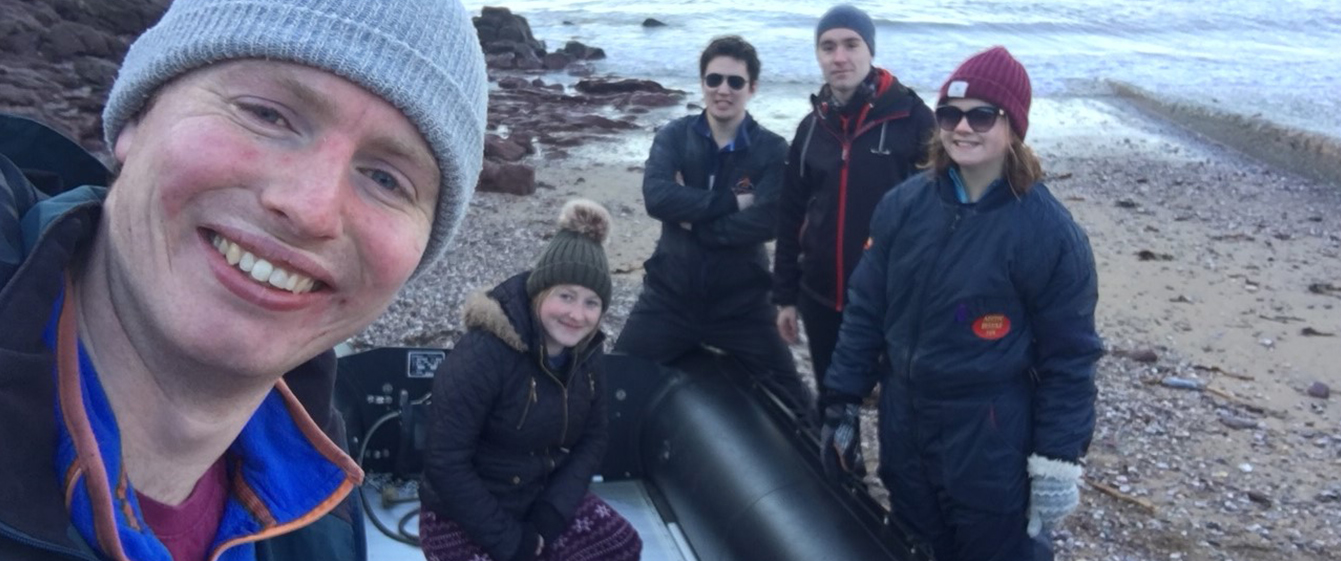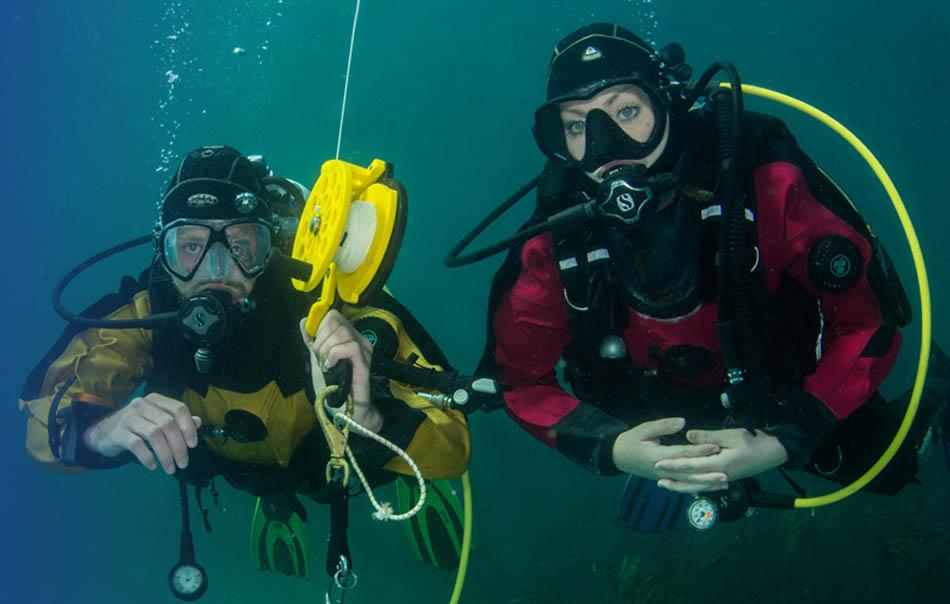
National Instructor and Open Water Instructor Chief Examiner Luisa Smith says that winter diving requires a different mindset alongside cold-water equipment.
With summer well and truly gone, many UK divers will be thinking of hanging up their fins for the winter. However, for those who want to appreciate what can be some of the best underwater visibility around the UK coast, diving throughout the winter is an exciting prospect. The key to an enjoyable winter season is planning and preparation.
Different equipment is probably the first thing that people think of when talking about diving in the winter. It is important to make sure that your regulators are appropriate for cold-water diving and are serviced. In the December 2018 issue of SCUBA, National Instructor Marg Baldwin wrote much more about suitable kit choices in her article Be Cool: the art of winter diving.
But it isn’t just the make and model of your regulator that you need to consider. You need to think about how you approach winter dives. For a start, there’s the psychology of it: anticipating the conditions may well make you feel cold before you get anywhere near the water.
Then there’s the physics: when the compressed gas in a diving cylinder flows through the cylinder valve and regulator first stage, the gas pressure is significantly reduced. This causes a dramatic fall in the temperature of the gas as it passes through to the second stage of the regulator. Any moisture in the gas or any water droplets can freeze and if they do, they will build up around the valve mechanisms with each breath, until the valve is stuck open in free flow.
In cold air temperatures, it is good practice to keep your kit as warm as you can, so don’t leave it lying on the cold ground. It also makes sense to adapt how you check your kit before entering the water. Normally during an open circuit diver’s buddy check, you’d breathe from your own regulator to confirm that it works, then ask your buddy to breathe off your alternate supply (AS) to check that too.
A more appropriate method of performing this part of your buddy check in the cold is to briefly depress the purge button to confirm gas will flow freely, but not to breathe from the regulator at this point. When both you and your buddy enter the water, that is the time to put the second stage in your mouth and take some deep, steady breaths with your head underwater, to ensure all is working and the gas tastes good.
Another time that a free flow can become a risk is at the end of the dive, using your AS to fill your delayed surface marker buoy. If you use a dSMB with its own small cylinder (often known as a crack bottle) or a carbon dioxide cartridge attached, you avoid this risk.
Staying warm
Remembering back to your very first Ocean Diver lectures, you may recall that water conducts heat 25 times faster than air, so divers lose heat faster in the water than when standing on dry land.
There are three things that govern how quickly you lose heat in the water: the ambient temperature of the water; the heat produced by a diver due to the level of work done (finning); and the time spent in the water. While it may seem logical that you will get cold faster when diving in cold conditions and you should reduce your dive time, how many people would give consideration to the type of dive that they were doing? If you are swimming, exploring a scenic wall or wreck, or better still having to fin into a slight current, you will stay warmer than if you are floating along on a drift dive.
Not surprisingly, you also need to consider what you wear. The insulating layers that you wear under your drysuit in summer months are not going to be sufficient during the winter. There are a multitude of warm, insulating layers available to buy, depending on whether you prefer one or two-piece garments or a particular type of material. The most important feature of underclothing is that it not only fits you well but also fits under your drysuit, without causing any pressure on your body or impeding the flow of air to the dump valve. Warm socks or booties are vital, but if there is not a lot of space in your boots, cramming your feet into a thick pair of socks will actually give you colder feet due to the pressure on them.
For those considering a lot of cold water diving, a heated vest may be a worthwhile investment and they are as useful during the surface interval as they are underwater… just make sure the batteries are charged.

Considering what you wear is a key part of staying warm on winter dives
The most important feature of underclothing is that it not only fits you well but also fits under your drysuit, without causing any pressure on your body.
Maintaining dexterity
With prolonged exposure to cold water, your body will protect its core temperature by constricting blood vessels supplying the extremities (hands, feet, face, ears) to reduce blood flow to these areas, which will then reduce the amount of heat lost. This is called peripheral vasoconstriction. The vasoconstriction will eventually lead to numbness in these areas, which has an important impact as it will affect your dexterity.
Anyone who has tried to deploy a delayed surface marker buoy (dSMB), or use the function buttons on their computer or rebreather, with numb fingers will appreciate how much more effort these simple tasks require. In the extreme, these tasks become impossible. To avoid problems, you need to consider the end of your dive. If you have to deploy a dSMB you must do this before your hands cool off too much to lose function. If you are doing a shore dive can you still take your fins off to exit the water if you have cold hands? If you are diving from a small boat, can you de-kit unaided in the water? If your hands are becoming numb it can be virtually impossible to undo simple clips or your drysuit direct feed. If you are concerned that you may struggle in these circumstances, is there anyone on the shore (or in the boat) who will be able to help?
You may think that the logical answer to cold hands is to wear thicker gloves. Although this will offer more insulation, using either thicker neoprene gloves, or thick mitts can also affect your dexterity. My personal preference is a pair of 5mm neoprene mitts in winter, as my fingers stay warmer when they are enclosed together. However, it took practice to be able to kit up and dekit without all my fingers available. Alternatively, there are many dry-glove systems available, and you can choose to wear different under-gloves with them, but this may again affect your dexterity. You should practice all your skills with your winterweight insulation in place, to ensure that you can still perform them well.
Use your head
In Ocean Diver training we also learn that 40% of heat loss is from the head and face. This is important to remember when diving in cold water. A thicker hood is definitely advisable, and maybe a differently shaped one that fits lower over your forehead and higher over your chin, so that less of your face is exposed to cold water. But you’ll need to try it out to make sure that it works with your other kit.
If you suffer from that feeling of ‘ice cream head’ in cold water, learning to use a full-face mask, which encloses your mouth and nose and has an integrated second stage, may be a better option. This will keep all of your face dry and provide an insulating layer of air between your face and the water. Of course, you should be suitably trained and certified in the use of the full-face mask and an appropriate pre-dive brief should be given.
In the winter, it is even more important than usual to ensure that your drysuit doesn’t leak so that your underlayers remain dry and retain their full insulating properties. You could also use a second dry hood and a dry pair of gloves for your second dive, to further insulate your extremities.
Even with the use of appropriate insulation, you will get cold during a cold-water dive. Bear in mind that if you are planning a multi-dive day, the effects of the cold could be cumulative and could end up affecting you more than you might anticipate. It might be better to plan your diving so that you only do one dive a day, allowing you to fully recover before your next dive.
Another way that you can conserve heat is to consider what you eat and drink. Following a cold dive, having a warm drink is a good way of rewarming. An even better option is hot soup or a stew, which not only provides warmth but is also a good source of nutrition. If you don’t feel like a meal immediately after a dive, a cup of hot chocolate made with milk will provide at least some protein and carbohydrate and warm you up from the inside.
The other thing to think about is shelter after a dive. Exposure to any wind on the wet outer surface of a diving suit will cool you. As soon as you have left the water and removed your diving equipment, you want to be able to shelter from any wind. This could be as simple as putting on a wind-proof coat, sitting in a wind-proof shelter (small tents can be useful for this purpose), or a heated space such as a hard boat cabin.
If, as a diver, you are becoming cold you should alert your buddy and end the dive; if you are feeling cold it is likely that your buddy will also be cold. Cold impairs your ability to think and react, especially in stressful situations. Be aware that you are already on the edge of the incident pit. Cold conditions can also cause you to tire sooner, as your body concentrates on maintaining core temperature. It is far safer to have a short and enjoyable dive.
What next?
Cold-water diving in the UK can offer some of the best viz of the year, but it’s not for everyone. If you try it and don’t like it you can always take part in winter expeditions as part of the surface team. On the other hand, a more extreme version of winter diving is diving under ice, and BSAC offers an Ice Diving Skill Development Course, which includes much useful, and interesting, information about coldwater diving. Maybe you should give it a try?
BSAC members save £££s every year using BSAC benefits.
Join BSAC today and start saving on everything from scuba gear, diving holidays and diver insurance, to everyday purchases on food, online shopping and retail with BSAC Plus. Click to join BSAC today.
This Learning Curve article was originally published in SCUBA magazine, Issue 97 December 2019.
Images in this online version may have been substituted from the original images in SCUBA magazine due to usage rights.




